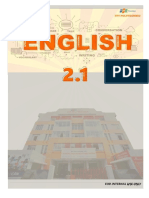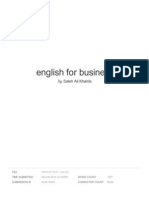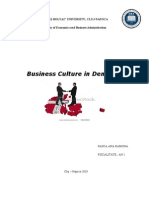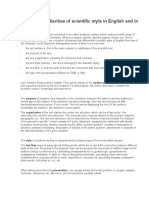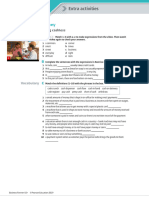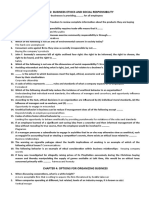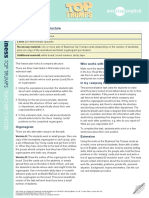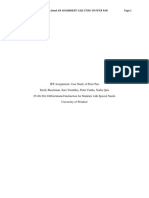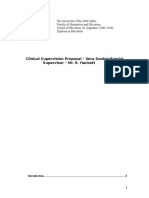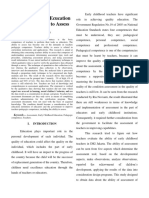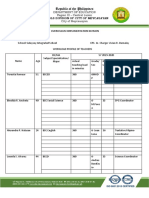HOW TO WRITE A CV IN Module: Business English.
Lesson: 4
ENGLISH
�OBJECTIVES OF THE LESSON:
This lesson will help you: ▪ Understand how to best describe
▪ Understand what a CV or Resume is your educational background when
and what is the difference between putting your Resume in English
them. together.
▪ Learn what to include in the personal ▪ Write about different skills and
profile section of your CV in English. hobbies you have to best represent
▪ Find the correct words and phrases to yourself as a desirable employee on
describe your previous employment so your CV in English.
your CV in English can stand out in the
crowd.
�THE DIFFERENCE BETWEEN A
RESUME AND A CV:
• ‘CV’ and ‘resume’ have the same meaning.
• The word ‘CV’ is more common in the UK, while ‘resume’ is more common in the USA.
• Although some people say that there’s a difference, in everyday speech, a CV and
a resume are the same thing: you write a summary of your employment history,
your education and your skills in order to apply for a job.
• Most resumes in the United States are competency-based: they are personal
marketing documents intended to showcase the candidate’s skills, notable
achievements, and work experience to the greatest advantage.
• US CVs, submitted for jobs in academia, scientific research, and medical fields,
are credential-based, providing a comprehensive (and often lengthy) listing of
one’s education, certifications, research experience, and professional affiliations
and memberships.
� RESUME VS CURRICULUM
VITAE
Length
• One page. • Multiple pages.
Purpose
• Highlight your personal and • Comprehensive history of your
professional accomplishments. educational and professional life.
organization
• Tailored to a specific job listing. • Sections are organized in reverse
• Can take on a variety of formats. chronological order.
• Any person applying for a job. • For instance teachers applying for positions abroad.
• Or researchers applying for specific positions.
Who needs one?
� 1. HOW TO WRITE A PERSONAL
PROFILE
Your personal profile is a short introduction of you:
• your key skills and your career goals.
• four to five sentences.
• full sentences in the first person.
1- Introduce yourself
Eg:
I am a web development professional looking to move into a senior role in
an established company.
I am a cardiology nurse with over ten years’ experience in Spain; I am now
looking for a position in the UK.
• Here, you can see language which you could adapt to your situation:
Eg:
I recently graduated from ________.
I am a ________ professional looking to move into a ________ role.
I am a ________ with over _______ years’ experience.
�2 – Add the skills you will bring to the job you’re applying for:
• Be specific and focus on facts.
• Avoid using clichés like ‘team player’, ‘good communicator’ or ‘passionate’. These are overused in job
applications.
• Organise your ideas using time references, like ‘during’, ‘over the last … years’, ‘recently’, or ‘since…’.
• Avoid repetitive sentence structures. It doesn’t sound good if every sentence you write starts with ‘I’
Eg:
- Over the last fifteen years, I have honed my technical skills by working on a wide range of projects, both working
individually and in large teams to learn and develop my skills. Recently, I have developed my managerial abilities by
working as a team leader for my current employer.
- Since I started working as a ward nurse, I have pursued every opportunity specialised cardiology nurse for the past
five years.
3 - End your personal profile with a sentence summarising your career goals.
Eg:
- I hope to build on my prior experience and make a meaningful contribution by working in an international NGO.
- Having worked mostly for start-ups and smaller firms, I would now like to challenge myself by managing projects and
teams in a larger company.
- My short-term goal is to work in an English-speaking environment, with a view to moving into a training/teaching role
in the medium term.
� 2. HOW TO WRITE ABOUT YOUR
EMPLOYMENT HISTORYIn this section of your CV, you should:
• List the companies you’ve worked for.
• The dates you worked there.
• Your responsibilities.
• Any significant achievements.
Eg:
Customer service supervisor, Juice-It, September 2016
to January 2019.
Main responsibilities: responding to customer queries
and complaints, creating and implementing surveys to
gather customer feedback, organising training sessions
for other staff members.
�Concerning the responsabilities, it is preferable to
list them and to use one style of writing and to use
active, specific vocabulary.
There are two possible styles you can use:
- To write sentence fragments starting with an -ing
verb.
- To write sentence fragments starting with a past
simple verb.
Eg:
Designed training programs for other staff members.
Eg:
instead of ‘Making promotional materials in print
and digital formats’, say ‘Creating promotional
materials’ or ‘Designing promotional materials’.
Instead of ‘Worked with customer data to suggest
alternative strategies for sales team members,’ say
‘Analysed customer data in order to devise more
effective strategies for sales team members’.
�3. HOW TO WRITE ABOUT YOUR
EDUCATION
On most CVs, education either goes at the top, after the personal profile, or after the work
experience section. Here, you list the institution, qualification, grades and dates.
Eg:
[2017 – 2019] Master degree in linguistics and didactics of foreign languages– Bouzareah,
Algiers.
The year – the degree – the place
This might be all you need, but you might also add modules you studied, projects you worked
on, or the title of your thesis or dissertation. Here, the simplest way to add this information is
to use a colon to introduce a list, like this:
Modules studied: marketing, economics, business English, etc….
Depending on where you are in your career, you might not need a lot of details about your
education. If you’ve been working in your field for many years and have lots of relevant
achievements, then you probably don’t need to go into details about your education.
�4. WRITING ABOUT SKILLS AND
HOBBIES
At the end of your CV, you might list relevant skills, such as other languages which you speak,
certificates, or software you can use. You might also list your hobbies and interests. Here, you
can keep this simple; introduce a list using a colon, like this:
Proficient with: Adobe Photoshop, Illustrator and InDesign, MS Office, QuickBooks.
The levels of your skills:
You can show different levels of skill by using different adjectives like ‘proficient’, ‘familiar’, or
‘competent’. ‘Proficient’ suggests a higher level of skill; ‘competent’ suggests a medium degree,
while ‘familiar’ suggests a more basic level of skill. You can use these adjectives with the
preposition ‘with’ plus a noun; for example: ‘proficient with AutoCAD’, ‘competent with
WordPress’, or ‘familiar with a range of common double-entry bookkeeping applications.’ You
can also use some adjectives like this plus ‘at’ plus an -ing verb. For example:
Competent at building and styling web pages using HTML and CSS.
Skilled at using a range of Abode Creative Suite applications for graphic or print design.
�The languages: The hobbies:
With languages, you can use a similar Finally, you can add your hobbies and interests if you
format; introduce a list using a colon, like want. Eg: Hobbies and interests: surfing, DIY, arts and
this: crafts.
Languages spoken: Arabic, Spanish,
At this point, your CV should be close to complete.
Portuguese.
Don’t forget to proof read carefully before you send
If you want to add additional information to it! In most situations, recruiters won’t spend long the
something, add it in parentheses, like this. first time they look at your CV. Even small things, like
Languages spoken: Arabic (fluent), French spelling mistakes, can mean your CV gets thrown out.
(intermediate), English (basic). So, take the time to check everything.
As before, you’re not writing in full sentences
here. That means you can be flexible with
the structure; for example, you don’t need to
add ‘and’ between the last two items on
your list. However, you should still pay
attention to grammar and structure, because
it’s important to be consistent.











